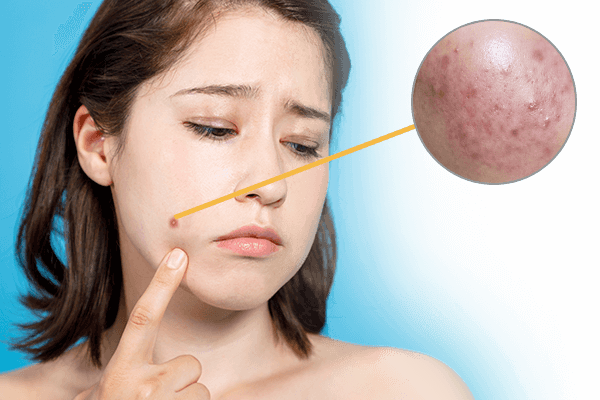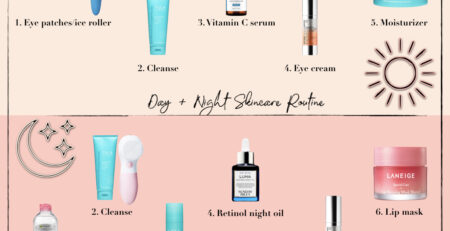Acne Problems & Treatments
Zits. Pimples. Spots. Whatever you call it, acne can cause discomfort and embarrassment. This skin condition affects most people at some point during their lives. About 4 out of every 5 people experience acne outbreaks between the ages of 11 and 30.
Acne is a chronic, inflammatory skin condition that causes spots and pimples, especially on the face, shoulders, back, neck, chest, and upper arms.
Whiteheads, blackheads, pimples, cysts, and nodules are all types of acne. Acne starts in the skin’s oil glands. The hair on our bodies comes out through canals from these glands called follicles. Oil glands make oils that emerge to the skin’s surface through the follicles’ openings, or pores, along with the hairs.
Sometimes hair, oil, and dead skin cells come together to plug a follicle. The plugged pore provides the right conditions for bacteria that normally live on the skin to thrive. When the body’s immune system attacks the bacteria, pain and swelling can result. That’s how a pimple forms.
What are the different types of acne?
Acne can take several forms. They include:
Blackheads: Open bumps on the skin that fill with excess oil and dead skin. They look as if dirt has deposited in the bump, but the dark spots are actually caused by an irregular light reflection off the clogged follicle.
Whiteheads: Bumps that remain closed by oil and dead skin.
Papules: Small red or pink bumps that become inflamed.
Pustules: Pimples containing pus. They look like whiteheads surrounded by red rings. They can cause scarring if picked or scratched.
Fungal acne (pityrosporum folliculitis): This type occurs when an excess of yeast develops in the hair follicles. They can become itchy and inflamed.
Nodules: Solid pimples that are deep in your skin. They are large and painful.
Cysts: Pus-filled pimples. These can cause scars.
All of these forms of acne can affect your self-esteem. It’s best to seek help from your healthcare provider early so they can help determine the best treatment option(s) for you.
How severe can acne get?
Dermatologists rank acne by severity:
Grade 1 (mild): mostly whiteheads and blackheads, with a few papules and pustules.
Grade 2 (moderate, or pustular acne): multiple papules and pustules, mostly on your face.
Grade 3 (moderately severe, or nodulocystic acne): numerous papules and pustules, along with occasionally inflamed nodules. Your back and chest may also be affected.
Grade 4 (severe nodulocystic acne): numerous large, painful and inflamed pustules and nodules.
Fast facts on acne
Here are some facts about acne. More detail is in the main article.
- Acne is a skin disease involving the oil glands at the base of hair follicles.
- It affects 3 in every 4 people aged 11 to 30 years.
- It is not dangerous, but it can leave skin scars.
Treatment depends on how severe and persistent it is.
Risk factors include genetics, the menstrual cycle, anxiety and stress, hot and humid climates, using oil-based makeup, and squeezing pimples.
Human skin has pores that connect to oil glands under the skin. Follicles connect the glands to the pores. Follicles are small sacs that produce and secrete liquid.
The glands produce an oily liquid called sebum. Sebum carries dead skin cells through the follicles to the surface of the skin. A small hair grows through the follicle out of the skin.
Pimples grow when these follicles get blocked, and oil builds up under the skin.
Skin cells, sebum, and hair can clump together into a plug. This plug gets infected with bacteria, and swelling results. A pimple starts to develop when the plug begins to break down.
Other causes include:
Some medications that contain androgen and lithium
- Greasy cosmetics
- Hormonal changes
- Emotional stress
- Menstruation
How Can Acne Be Prevented?
To prevent acne and reduce its damage to your skin, follow these tips.
Choose a cleanser specially formulated for acne. These products often contain salicylic acid or benzoyl peroxide, which help to clear acne sores.
Clean your face gently, as trauma to the acne breakouts may worsen the acne or cause scarring. When washing your face, use your hands or cotton pads, as any terry cloth or other scrubbing material may cause acne sores to rupture.
If you need to use a moisturizer, use only light, non comedogenic moisturizers, which do not aggravate acne.
If you are a woman, use an oil-free foundation. Heavy makeup or other cosmetic products that block pores may cause a flare-up of acne.
Treatment depends on how severe and persistent the acne is.
Acne can be treated with over-the-counter (OTC) medications, such as gels, soaps, pads, creams, and lotions that are applied to the skin.
Creams and lotions are best for sensitive skin. Alcohol-based gels dry the skin and are better for oily skin.
OTC acne remedies may contain the following active ingredients:
Resorcinol: Helps break down blackheads and whiteheads
Benzoyl peroxide: Kills bacteria, accelerates the replacement of skin, and slows the production of sebum
Salicylic acid: Assists the breakdown of blackheads and whiteheads and helps reduce inflammation and swelling
Sulfur: Exactly how this works is unknown
Retin-A: Helps unblock pores through cell turnover
Azelaic acid: Strengthens cells that line the follicles, stops sebum eruptions, and reduces bacterial growth. There is cream for acne, but other forms are used for rosacea.
It is advisable to start with the lowest strengths, as some preparations can cause skin irritation, redness, or burning on first use.
These side effects normally subside after continued use. If not, see a doctor.
Home remedies
There are many suggested home remedies for acne, but not all of them are supported by research.
Diet: It is unclear what role diet plays in worsening acne. Scientists have found that people who consume a diet that offers a good supply of vitamins A and E and of zinc may have a lower risk Trusted Source of severe acne. One review describes the link between acne and diet as “controversial,” but suggests that Trusted Source a diet with a low glycemic load may help.
Tea-tree oil: Results of a study of 60 patients published in the Indian Journal of Dermatology, Venereology, and Leprology suggested that 5-percent tea-tree oil Source mild to moderate acne.
If you want to buy tea-tree oil, then there is an excellent selection online with thousands of customer reviews.
Moisturizers: These can soothe the skin Trusted Source, especially in people who are using acne treatment such as isotretinoin, say researchers. Moisturizers containing aloe vera at a concentration of at least 10 percent or witch hazel can have a soothing and possibly anti-inflammatory effect.
These good habits can help reduce acne:
Be gentle. Avoid scrubbing hard when washing your face.
Hands off. Resist the temptation to squeeze or pick at pimples. Wash your hair. If you have oily hair, washing it every day can reduce oil on the skin.





Leave a Reply